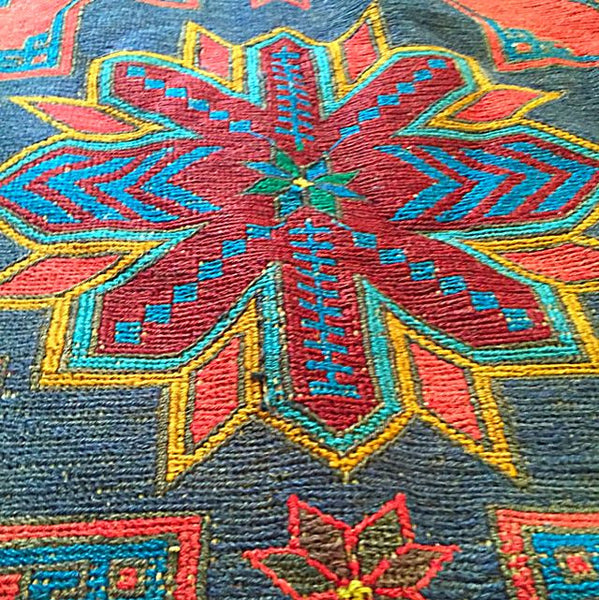



1960's Antique Russian Caucasian Soumak Rug Carpet, Museum Quality Tapestry, Unique Show Piece
Antique Russian Caucasian Soumak Rug, Ultra Rare With Very Beautiful & Sharp Features
- Massive Size 3.35 M X 2.19 M
- Hand Flat-Weave - Made in Tribal Village & NOT in Commercial Mills
- Rich Natural Dyes Colors
- Beautifully Put Together
- This Is A Rare Antique Tribal Weave And NOT Commercial Type Carpet
- Estimate approx. upwards of 50+ years old!
- Tapestry Show Piece or Museum Type
- Excellent Condition
- Wool on Wool (Antique Rugs are all of 100% Wool)
- Incredible One of its Kind Piece - Ultra Rare!
- Authenticity Guaranteed for Life
Viewing by Appointment Only.
Please feel free to email any questions - emporium.antiquities@gmail.com
_______________________________________________________
Caucasian Soumak Rugs- One of the most familiar types of antique weaving from the Caucasus region is the Soumak. These were produced in a wide array of designs, but generally they are typified by a crisp, precise drawing applied to highly abstract or stylized geometric patterns, using a rich and varied palette.
In technical terms, Soumaks are flatwoven rugs. Their technique is related to that of kilims, but it is somewhat more complex, thicker in handle, and more durable as floor covering. As opposed to Kilim technique which consists of compacted weft facing simply running over and under the vertical wraps, Soumak weave runs the yarns around the warps in a serpentine pattern, over two, back one, over two back one, and so forth.
The rows of this yarn facing or brocading are then separated by wefts like the rows of knots in pile carpets. The origin of this technique is hard to pinpoint, but it is attested literally from one end of the rug-producing world to the other.
The term Soumak is apparently a corruption of the name Shemaka, a town in the Shirvan region of the Caucasus, where such rugs, it is often claimed, were made. However Soumaks were made in various areas of the Caucasus and the region north of Kuba seems to have been a major center of their production.
Caucasian Soumaks have a very interesting design repertory, with a number of distinct types or groups. From the perspective of carpet history, the most interesting group is the one that utilizes field designs of large polygonal medallions, often in the shape of diamonds or stars.
These tend to be modeled on early Turkish pile carpets, especially those of the so-called “small pattern Holbein” and “large pattern Holbein” types produced in Western Turkey during the fifteenth and sixteenth centuries. A key feature of the Holbein design is the use of small squares with horn-like hooked pairs as fillers in the indentations along the edge of the main medallions.
Caucasian Soumaks of this type reproduce even these details with remarkable consistency and fidelity. The various smaller motifs used as space fillers seem to come from the common tribal repertory behind most Caucasian and Turkish rugs. The borders of Caucasian Soumaks tend to be made up of small geometric medallions or stylized rosettes, although they can be surprising, as on the example shown here which is adapted from kilim designs.
A second major group of Caucasian Soumaks have allover field designs made up of smaller medallions arranged closely in staggered repetition. Some of these which have multi-pointed star-like configuration (the so-called Crivelli-Star) also come from the repertory of early Turkish rugs. But the oval medallions with undulating edges are floral palmettes of classical Persian derivation.
Despite the varied origins of the design elements, the Soumaks of this group still convey considerable stylistic homogeneity or integrity. The borders of this second group are much the same as those of the first, although the example shown here has a highly unusual border that derives once again from early Turkish rugs.
A third group of Caucasian Soumaks stems from more local traditions. Known as “Dragon Soumaks,” these are clearly derived from the classical Caucasian Dragon rugs produced from the end of the sixteenth to the early eighteenth centuries.
The Dragon Rugs themselves were Caucasian workshop productions based on imported Kerman Persian Vase carpets, although the precise area of their manufacture is still unclear. The Soumaks of this kind were probably patterned on the village derivatives of the Dragon rugs that were produced in the Karabagh region during the later eighteenth and early nineteenth centuries.
Another, possibly related type are the Verneh Soumaks that have designs consisting of large, angular S-shaped motifs which are generally thought to be dragons, although in most cases they are no longer recognizable as such.
. ~AU'Listings~ . .~Ou'Antiquities~.




